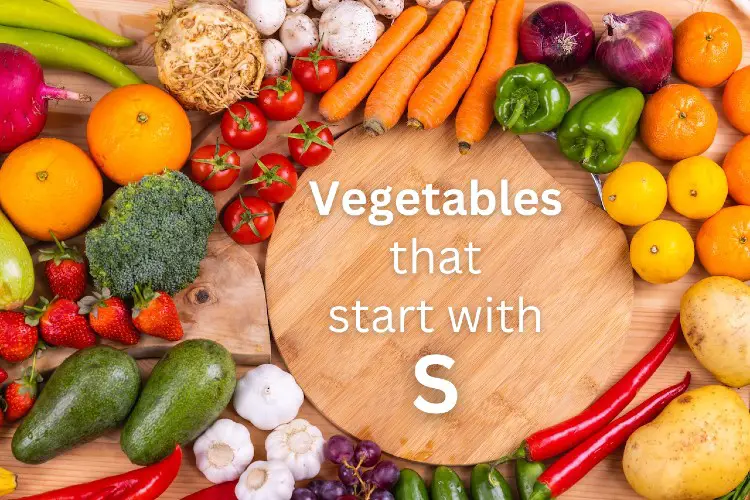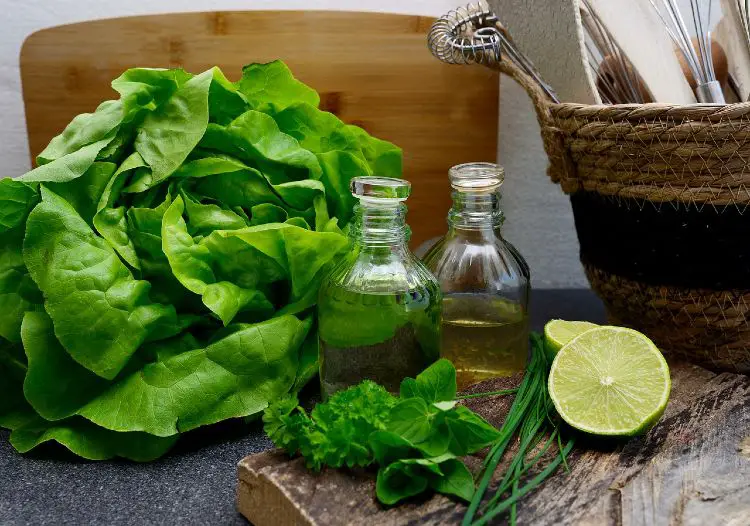Vegetables That Starts with S
Welcome to our comprehensive list of vegetables that start with the letter S!
Whether you’re seeking spinach or shallots, we’ve got you covered with a collection of amazing veggies.
Our list includes a variety of vegetables starting with S, and we’ve provided detailed information, along with links to recipes, so you can explore and enjoy these vegetables to the fullest.
But wait, there’s more! If you happen to know of any other vegetables that start with S that we might have missed, we would love to hear from you. Leave a comment, and we’ll gladly add them to our list of veggies beginning with S.
Get ready to discover and savor a wide range of delicious vegetables that all share a common trait – their names start with the letter S!
Vegetables Beginning With S
Here is the list of vegetables starting with S.
- Spinach
- Salsify
- Sweetcorn
- Samphire
- San Maranzo Tomatoes
- Savoy Cabbage
- Scorzonera
- Sea Beet
- Sea Kale
- Seaweed
- Serrano Pepper
- Scallions (Spring Onions)
- Shallots
- Shiitake Mushrooms
- Silverbeet
- Snow Peas
- Sorrel
- Soya Beans
- Spaghetti Squash
- Spring Greens
- Sugar Snap Peas
- Summer Squash
- Sweetheart Cabbage
- Sweet Potato
- Swede
- Swiss Chard
- Salad Savoy
- Sculpit
- Sea Grape
- Sea Lettuce
- Shallot
- Sierra Leone Bologi
- Skirret
- Soko
- Sour Cabbage
- Squash Blossoms
Details of Vegetables Starting with Letter S
Spinach
Spinach is a leafy green vegetable that is rich in nutrients, including vitamins A, C, and K, as well as iron and calcium.
It has a mild, slightly earthy flavor and can be eaten raw in salads or cooked in various dishes.
Spinach is a versatile ingredient and a popular choice for adding nutritional value to meals.
Salsify
Salsify, also known as the oyster plant, is a root vegetable with a unique taste reminiscent of oysters.
It has a long, slender shape and a brownish-black skin.
Salsify can be cooked and used in soups, stews, or as a side dish.
People love it for its distinct flavor and its contribution to diverse culinary creations.
Sweetcorn
Sweetcorn, also called corn or maize, is a popular cereal grain known for its sweet and juicy kernels.
You can enjoy it fresh, boil it, grill it, or use it in various dishes such as salads, soups, or salsas.
Sweetcorn is a good source of dietary fiber, vitamins, and minerals.
It is a staple in many cuisines around the world and is particularly celebrated during the summer months.
Samphire
Samphire, also known as sea asparagus or sea pickle, is a succulent green vegetable that grows in coastal areas.
It has a crisp texture and a salty taste, similar to that of seaweed.
You can eat samphire raw in salads, blanch it, or lightly sauté it.
It is a popular ingredient in seafood dishes and adds a unique briny flavor.
San Marzano Tomatoes
San Marzano tomatoes are a variety of plum tomatoes known for their sweet, rich flavor and firm texture.
In Italian cuisine, people commonly use San Marzano tomatoes, particularly for making sauces and tomato-based dishes.
San Marzano tomatoes are prized for their distinct taste, low acidity, and deep red color.
Savoy Cabbage
Savoy cabbage is a type of cabbage with crinkled leaves and a mild, slightly sweet flavor.
You can use it in a variety of dishes, such as stir-fries, soups, or stuffed cabbage rolls.
People like them for its tender texture, attractive appearance, and nutritional value.
Scorzonera
Scorzonera, also known as black salsify or Spanish salsify, is a root vegetable similar in appearance to a long, thin parsnip.
It has a dark brown or black skin and a white flesh. It has a unique flavor with hints of artichoke and oyster.
You can cook scorzonera and use it in soups, stews, or roasted dishes.
Sea Beet
Sea beet is a leafy green vegetable that grows along the coastlines. It has dark green leaves and a slightly salty taste.
You can use sea beet in salads, sauté it, or add it to various dishes as a substitute for spinach.
People appreciate it for its resilience in coastal environments and its ability to add a touch of brininess to meals.
Sea Kale
Sea kale is a coastal vegetable with large, wavy leaves and a mild, slightly bitter taste.
People often blanch or steam it before using it in salads, side dishes, or as a cooked green.
Sea kale is known for its ability to withstand harsh coastal conditions and its unique flavor profile.
Seaweed
Seaweed refers to a variety of marine algae that are edible and consumed in many cultures. It comes in various types, including nori, kelp, dulse, and wakame.
It is a nutritious food source, rich in vitamins, minerals, and antioxidants.
You can use it in salads, soups, sushi, or as a seasoning.
People like seaweed for its umami flavor and its contribution to the diverse world of sea-based cuisine.
Serrano Pepper
Serrano pepper is a type of chili pepper with medium heat and a bright, vibrant flavor.
It is smaller and hotter than jalapeno peppers, with a crisp texture. S
People often use serrano peppers in Mexican and Latin American cuisine to add heat and flavor to salsas, sauces, and other dishes.
Scallions (Spring Onions)
Scallions, also known as spring onions or green onions, are young onions harvested before the bulb has fully developed.
They have a mild onion flavor and are used in various culinary preparations, both raw and cooked.
People often use scallions as a garnish, add them to salads, stir-fries, or use them as a flavoring in soups and sauces.
Shallots
Shallots are small, bulbous onions with a mild, sweet flavor. They have a reddish-brown papery skin and a delicate, aromatic taste.
Shallots are versatile in cooking and are commonly used in French cuisine.
They add a subtle onion flavor and depth to sauces, dressings, and various dishes.
Shiitake Mushrooms
Shiitake mushrooms are a type of edible mushroom native to East Asia. They have a distinctive earthy flavor and a meaty texture.
People use shiitake mushrooms in a wide range of dishes, including stir-fries, soups, and sauces.
They are also known for their potential health benefits and are highly regarded in traditional medicine.
Silverbeet
Silverbeet, also known as Swiss chard or rainbow chard, is a leafy green vegetable with colorful stems and dark green leaves. It has a slightly bitter and earthy taste.
It is a good source of vitamins and minerals, including vitamin K and iron.
People commonly use silverbeet in Mediterranean cuisine, steaming it, sautéing it, or adding it to soups and stews.
Snow Peas
Snow peas are a type of pea with flat, edible pods and small, tender peas inside. They have a crisp and sweet flavor.
People commonly use snow peas in stir-fries, salads, and Asian-inspired dishes.
People like them them for their crunchy texture and their ability to retain their vibrant green color when cooked briefly.
Sorrel
Sorrel is a leafy green herb with a tangy, lemony flavor.
You can use sorrel in both raw and cooked preparations. People often add sorrel to salads, soups, sauces, or use it as a garnish.
It adds a bright and refreshing note to dishes and is particularly popular in French cuisine.
Soya Beans
Soybeans, also known as soya beans, are legumes that are widely cultivated for their edible seeds.
They are a significant source of plant-based protein and are used in a variety of forms, including tofu, soy milk, tempeh, and soy sauce.
Soybeans are a versatile ingredient in many cuisines around the world and are valued for their nutritional benefits.
Spaghetti Squash
Spaghetti squash is a winter squash variety named for its unique stringy flesh that resembles spaghetti strands when cooked.
It has a mild, slightly sweet flavor and can be used as a healthier alternative to pasta.
People often roast or boil spaghetti squash and serve it with sauces, vegetables, or protein.
Spring Greens
Spring greens refer to a variety of leafy green vegetables that are harvested in the spring.
They typically include young lettuce, arugula, spinach, and other tender greens.
People value spring greens for their fresh, vibrant flavors and commonly use them in salads, sandwiches, or as a side dish.
Sugar Snap Peas
Sugar snap peas are a type of edible pod pea that combines crispness and sweetness. The entire pod, including the peas inside, is edible.
People often eat sugar snap peas raw, add them to salads, or use them in stir-fries and other vegetable-based dishes.
People love them for their juicy texture and natural sweetness.
Summer Squash
Summer squash refers to various types of squash that are harvested during the summer, such as zucchini and yellow squash.
They have a mild, slightly sweet flavor and a tender texture.
You can use summer squash in a variety of dishes, including sautés, stir-fries, grilling, or as a base for pasta alternatives.
Sweetheart Cabbage
Sweetheart cabbage, also known as pointed cabbage, is a cabbage variety with elongated, cone-shaped heads.
It has a sweet and delicate flavor compared to other cabbage varieties.
You can use sweetheart cabbage in salads, slaws, stir-fries, or cook it as a side dish.
People like it for its tender texture and attractive appearance.
Sweet Potato
Sweet potatoes are root vegetables with a sweet and starchy flesh. They come in various colors, including orange, purple, and white.
Sweet potatoes are versatile and you can baked, boil, mash them or use in both sweet and savory dishes.
They are a good source of vitamins, fiber, and antioxidants.
Swede
Swede, also known as rutabaga or yellow turnip, is a root vegetable that resembles a large, round turnip with yellow flesh and a purple-tinged skin. It has a slightly sweet and nutty flavor.
People commonly use swede in soups, stews, roasted dishes, or mash it as a side dish.
It is a popular vegetable in Northern European cuisines.
Swiss Chard
Swiss chard is a leafy green vegetable with colorful stems ranging from white to red and dark green leaves. It has a mild and slightly earthy flavor.
You can cook Swiss chard and use it in various dishes, including sautés, soups, or as a substitute for spinach in recipes.
Salad Savoy
Salad Savoy, also known as curly endive or frisée, is a variety of chicory with curly, fringed leaves. It has a slightly bitter taste and a crisp texture.
People often use Salad Savoy in salads and it adds a decorative touch to dishes.
It pairs well with other greens, fruits, nuts, and dressings.
Sculpit
Sculpit, also known as garden sorrel or buckler leaf sorrel, is an herb with slender, arrow-shaped leaves and a tart, lemony flavor.
People commonly use it in Mediterranean and European cuisines as a seasoning or garnish for fish, soups, and sauces.
Sculpit adds a tangy freshness to dishes and is valued for its culinary and medicinal properties.
Sea Grape
Sea grape is a tropical fruit that grows in clusters on seaside trees. It has a round shape and a translucent, purplish skin.
Sea grapes have a unique taste, combining sweetness and slight tartness.
People often eat sea grapes raw or use them in salads, jellies, or jams.
Sea grapes are popular in coastal regions and are enjoyed for their refreshing flavor.
Sea Lettuce
Sea lettuce is a type of edible green seaweed with a delicate texture and a mild, slightly salty taste.
It is used in various cuisines around the world, particularly in Asian dishes like sushi or soups.
You can consume sea lettuce raw, lightly cooked, or dried.
It is appreciated for its vibrant color and contribution to ocean-inspired cuisine.
Shallot
Shallots are small, bulbous onions with a mild, sweet flavor. They have a reddish-brown papery skin and a delicate, aromatic taste.
Shallots are versatile in cooking and are commonly used in French cuisine.
They add a subtle onion flavor and depth to sauces, dressings, and various dishes.
Sierra Leone Bologi
Sierra Leone Bologi is a leafy green vegetable native to West Africa, particularly Sierra Leone.
It has dark green leaves with a slightly bitter taste.
People often use Sierra Leone Bologi in traditional African dishes, such as stews or sautés.
People value it for its nutritional content and its role in local culinary traditions.
Skirret
Skirret is a root vegetable that was popular in medieval Europe but is now less common. It has a sweet, nutty flavor and a crisp texture.
You can cook skirret and use it in various ways, such as roasting, boiling, or sautéing.
It is popular for its historical significance and unique taste.
Soko
Soko, also known as African nightshade or Ethiopian kale, is a leafy green vegetable common in East and Central Africa.
It has dark green leaves and a slightly bitter taste.
People use it in stews, soups, or sautés.
Sour Cabbage
Sour cabbage, also known as sauerkraut, is finely shredded cabbage that has been fermented by lactic acid bacteria. It has a tangy and sour taste.
People often use sour cabbage as a condiment, adding it to sandwiches, hot dogs, or serving it as a side dish.
People like it for its long shelf life, probiotic properties, and its use in traditional fermented foods.
Squash Blossoms
Squash blossoms are the bright yellow-orange flowers that grow on squash plants, particularly zucchini and pumpkin. They have a delicate, slightly sweet flavor.
Squash blossoms are often used in cooking, either stuffed, battered, and fried, or added to soups and quesadillas.
People often use squash blossoms in cooking, either stuffed, battered and fried, or adding them to soups and quesadillas.
That concludes our list of “Vegetables that start with S“! We hope you found it informative and helpful for your culinary endeavors.
We value your input! If you think there are any vegetables beginning with S that is missing in above list, please let us know in the comments section below.



